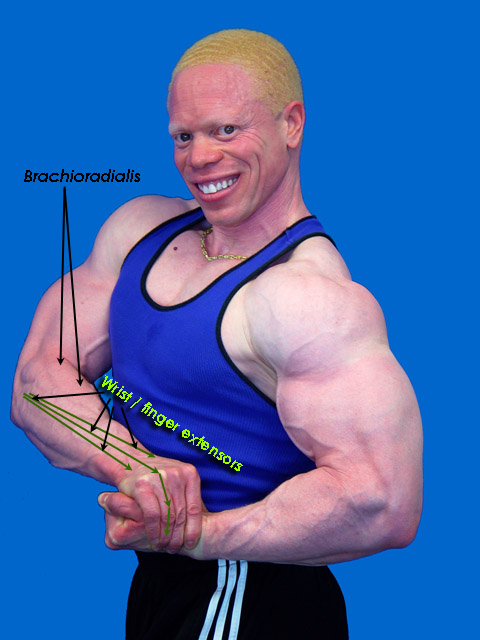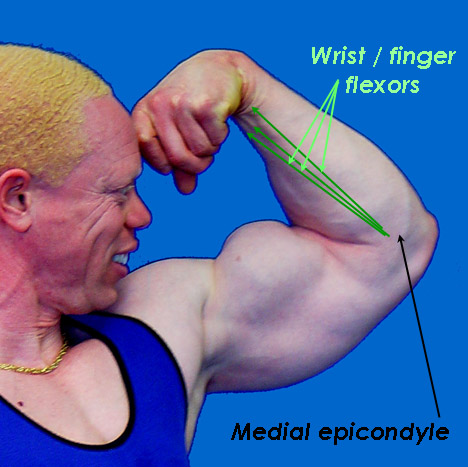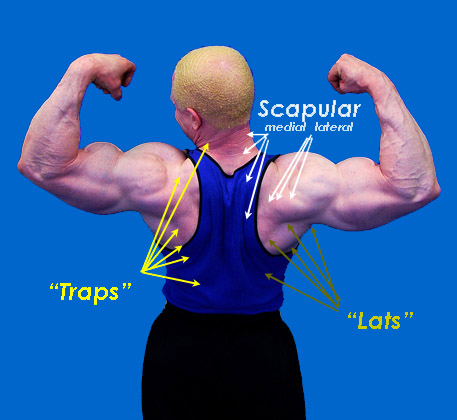|
Let's look at the surface muscles
of the upper body. 
The Trapezius
muscle covers the back of the neck, and runs in a big sheet out to the top of the scapula (wing bone). When well developed, it is the hypotenuse of the shoulder-neck triangle on the back side. It lifts the
shoulders in shrugging - pulling the shoulder blades upward and a bit inward.
The lower trapezius, between the blades, pulls the blades together backward - proud chest posture.
The Deltoid is three muscles glued together. When you hold your arms outward parallel to the floor, the deltoid
group is going strong. It has three zones all of which attach to the upper outer humerus. The front portion attaches along the clavicle (collar bone) and this zone also can pull
the arm up and forward. The middle portion starts at the very tip of the clavicle (on the acromion). It acts to only raise the arm outward. The posterior part of deltoid can raise the arm upward and backward.
The Triceps also has three muscle parts with a common single attachment. [This is a
theme in the body.] The attachment is the tip of the main moving elbow bone - the ulna (the tip is called the olecranon). The olecranon is to the elbow as the patella is to the
knee. It offers leverage to the muscular attachment. However, the other end of the triceps is more varied. A portion is centrally attached to the humerus. The medial
(nearer the body) portion travels up into the arm pit to attach to the scapula just adjacent the shoulder joint. Therefore this portion has tension change and action with
shoulder motion. The outer portion is , well, more outer.
The pectoral muscles attach along the breast bone (sternum) and converge ion the
upper humerus.
What you call the "biceps" isn't. That so called biceps bulge is like a double decker bus. The top deck is the biceps. It attaches to the shoulder blade just above the shoulder joint and to a little finger like protrusion (somebody thought it was more like a crows
beak) the acromion. Thus, biceps tension varies with shoulder position and movement and also can be used to move the shoulder. The biceps attaches - not to the ulna - but
to the radius. It attaches off center such that tension tends to rotate the radius to turn the forearm palm up (supinate). The biceps also has an attachment to the surface dense
tissue which envelops the forearm musculature. This second attachment called the lacertus fibrosis can sometimes squeeze the main nerve to the hand and cause buzzing
feeling. This may occur after injudicious weight lifting.
Deep to the biceps is the brachialis. The brachialis attaches along the humerus in the front and attaches to the ulna also in front. It is a pure elbow flexor. Typically, folks
don't recognize this muscle thinking the whole front bulge is biceps. Not. Often the brachialis is bigger than the biceps depending on how one uses the elbow or forearm.
 The brachioradialis is
a strange muscle. It is upside down. Like a salmon swimming against the current, it takes origin from the radial (outer) edge of the forearm, near the wrist, to attach to the outer lower edge of
the humerus. It is an elbow flexor that lives in the forearm. Cool. In addition to being geometrically weird, it is neurologically interesting as well. In stroke or cerebral palsy, this muscle may retain control
when the others have lost it. Surgeons like to use it to reconstruct lost function. The origin of this muscle is very close to the long thumb abductor tendon. Hmmmm. The brachioradialis is
a strange muscle. It is upside down. Like a salmon swimming against the current, it takes origin from the radial (outer) edge of the forearm, near the wrist, to attach to the outer lower edge of
the humerus. It is an elbow flexor that lives in the forearm. Cool. In addition to being geometrically weird, it is neurologically interesting as well. In stroke or cerebral palsy, this muscle may retain control
when the others have lost it. Surgeons like to use it to reconstruct lost function. The origin of this muscle is very close to the long thumb abductor tendon. Hmmmm.
The lower outer humerus has a stick out thingy called the lateral epicondyle. It is a handle of bone to which a glom of muscles attach. At this coming together the muscles
are all like one. Then as you go distally on the backside of the forearm, they split into three groups. An outer (radial) wrist extender. An inner (ulnar) wrist extender. And
finger extensors running down the middle of the other two.
Finger extensors cross the wrist as tendons. There are weird angular cross attachments
between the extensor tendons which explains why certain finger extensions in isolation are impossible for most of us.

The finger flexors have a similar scheme. They attach to the humerus from an inner side stick out thingy called the medial epicondyle. All the flexors glom
together as one unit near their origin high in the forearm. As you go distally along the forward surface (ventral surface) toward the wrist, the muscles form three groups. The medial wrist flexors, the lateral
wrist flexors and down the middle the finger flexors.
Note, the finger flexors attach to the humerus above the elbow and thus they are also
elbow flexors. You can see that finger and wrist flexors also elbow flex. Further, to NOT flex the elbow when the fingers are strongly gripped in flexion requires that elbow extensors be active.
Cocontraction is a term used when muscles fire on both sides of a joint in seeming self
annulment. Cocontraction stabilizes joints. Powerful joint usage typically requires that muscles on both sides be active. Indeed the biceps may be the real extensor in a sense
when something of value is being put down. Lowering, or controlled release, is a common usage. Training a muscle to shorten with use, such as having the biceps flex
with curling weights is one kind of usage. But lowering the weights slowly after shortening is another - and often more difficult act.
When the muscle group shortens with use, it is called concentric activity. When the muscle group holds a fixed position with no length change, it is called isometric activity. When a muscle lets up in a resisting way way so as to control lengthening, it is called eccentric activity. You will often hear the term "contraction" used for all three which is really confusing as that word means shorten. If enough of us just stop using that term it
might just go away. "Activation" is better.

Here we see the posterior deltoid pulling
the arms backward assisted by the trapezius muscles.
The upper portion of the trapezius pulls upward. The uppermost part of the trapezius is at the base of the skull in the back. The trapezius as much extends the head as raise the shoulder blades. The portion of
the trapezius below the top edge of the wing bone primarily pulls the wing bone (scapula) toward the midline.
Deep to the trapezius is a second layer of similar muscle in two portions. The levator muscles and rhomboid muscles also pull the upper medial border of the wing bone
upward and toward midline.
The latissimus dorsi muscles (lats) strongly pull the outer and lower edges of the scapula
downward and backward. These are muscles key to butterfly swimmers in the power stroke. Similar to the posterior portion of the deltoid is what looks like a fourth even more posterior part of the deltoid, the teres muscles.
The teres muscles come off the outer edge of the scapula to attach to the humerus but
not in the same spot as the deltoid (lateral) but rather to the cuff of muscles that also outwardly rotate the humerus (as seen here). Two other muscles sitting on the surface of the scapula (supra and infra spinatus) covering its back side also join the teres in
forming a cuff - the rotator cuff - which gets extra leverage by attaching to the greater tuberosity (a bump for leverage) on the top of the humerus.
The deep surface of the scapula is covered by the subscapularis which attaching to the lesser tuberosity cause inward arm rotation.
|